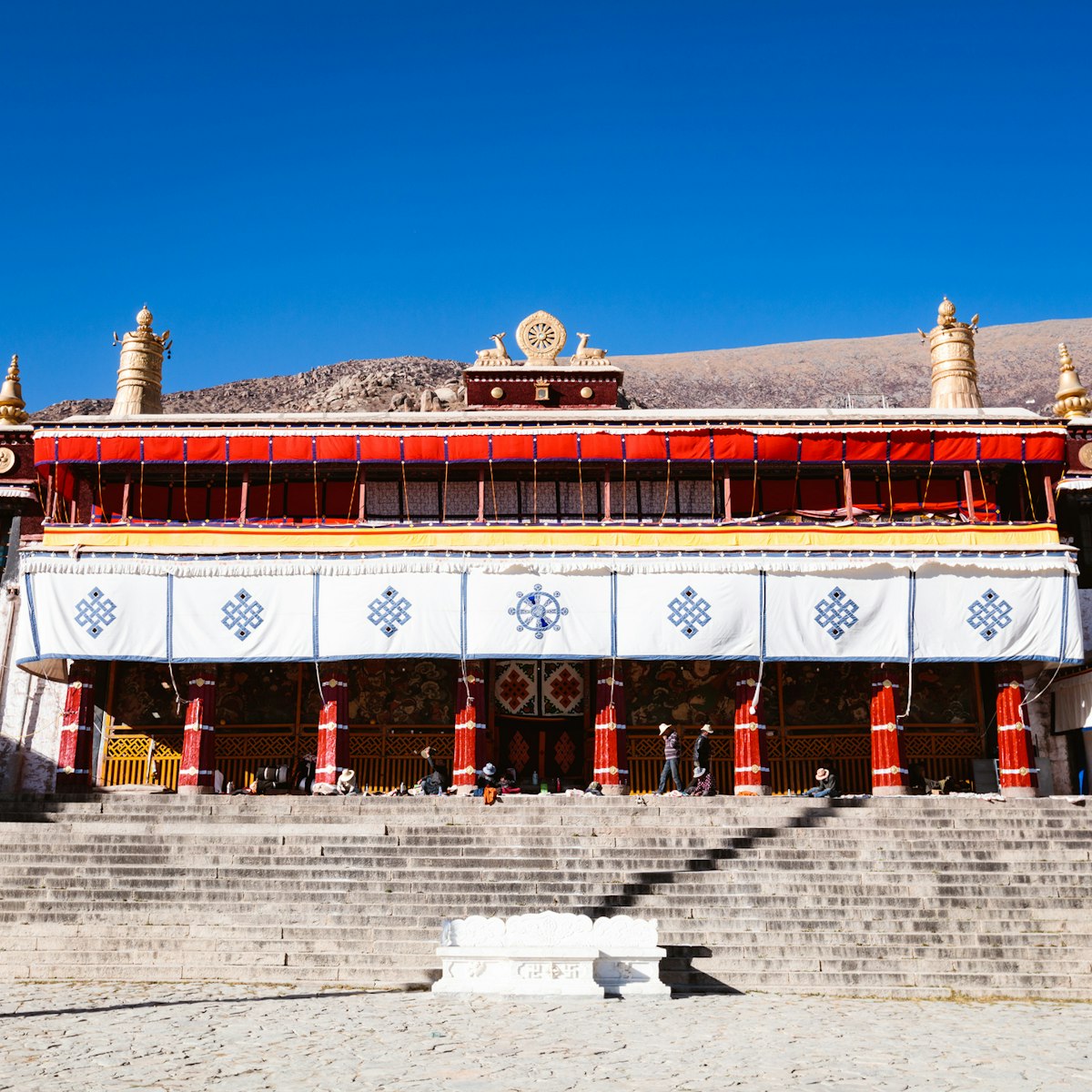Built by King Songtsen Gampo in the 7th century, Pabonka Monastery is one of the most ancient Buddhist sites in the Lhasa region. Though one of the lesser-visited monasteries in the area, it is only a short detour from Sera Monastery. Built on a flat-topped granite boulder said to resemble a tortoise, Pabonka's timeless chapels may even pre-date the Jokhang and Ramoche.
King Songtsen Gampo and his Chinese wife Princess Wencheng, as well as Tibetan king Trisong Detsen, Guru Rinpoche and Tibet’s first seven monks, all meditated here at various times. The original nine-storey tower was destroyed in 841 by the anti-Buddhist King Langdharma but rebuilt in the 11th century. The fifth Dalai Lama added an extra floor to that two-storey building. It suffered damage in the Cultural Revolution and has undergone repairs in recent years.
Rigsum Gonpo Temple
This temple is the first you come across when visiting Pabonka Monastery. The most famous relic is the blue and gold carved stone mantra ‘Om mani padme hum’ (‘Hail to the jewel in the lotus’) that faces the entrance on the far side of the hall. It is said to have been carved by Tibetan minister Thonmi Sambhota, who created the Tibetan script here after a visit to India. The central shrine contains a 1300-year-old ‘self-arising’ stone carving depicting Chenresig, Jampelyang and Chana Dorje (Vajrapani) – the Rigsum Gonpo trinity after which the chapel is named. The stone carvings were buried during the Cultural Revolution and only dug up in 1985.
Palden Lhamo Cave
It is said that King Songtsen Gampo once meditated in this cave. Images inside are of Songtsen Gampo (with a turban), his two wives, Guru Rinpoche, Trisong Detsen (in the corner) and a rangjung (self-arising) rock carving of the protectress Palden Lhamo.
The cave is located just uphill from the Rigsum Gonpo Temple, on the west side of the Pabonka rock (said to represent a female tortoise).
Pabonka Podrang
This temple atop the Pabonka rock is what remains of the original nine-storey palace. The upper floor has an intimate assembly hall with a ‘self-arising’ Chenresig statue hidden behind a pillar to the right. The inner protector chapel has a statue of red-faced local protector Gonpo Dashey Marpo (second from the right) next to an impressive stag's head. The four-pillared Kashima Lhakhang next door is lined with various lamas, ministers, three kings and their wives. The cosy rooftop quarters of the Dalai Lama have a statue of the meditational deity Demchok (Chakrasamvara). A legend claims that it was here that Songtsen Gampo first hatched the plan of building the Potala Palace on top of Marpo Ri, which is clearly visible from here.
Gyasa Podrang
The yellow Gyasa Podrang (Princess Wencheng Temple) sits above the Pabonka Podrang and the remains of 108 chörtens at the top of Pabonka Monastery. The two ground-floor rooms are dedicated to different manifestations of the medicine buddhas and Tsongkhapa, and an upper-floor chapel has a small statue of Wencheng herself in the far right, near an image of Thonmi Sambhota.
Songtsen Gampo’s Nepali wife Bhrikuti is also present, as are images of green and white Drölma, of whom the two wives are thought to be emanations. Also present is Gar Tongtsen, the Tibetan minister who travelled to the Tang Chinese court to escort Princess Wencheng back to Tibet.
Just next to the Gyasa Podrang, and next to rows of photogenic white chortens, is a new lhakhang housing the funeral stupa of Tantric teacher Nakchang Rinpoche.
Getting There
To get to Pabonka, take bus 20 from Beijing Donglu to the Sera Monastery turn-off on Nangre Beilu. A paved road branches left before the military hospital and leads all the way to Pabonka and Chupsang. You’ll soon see Pabonka up ahead to the left, perched on its granite boulder. The ‘monastery’ to the right is actually Chupsang Nunnery. A ride from the junction in a minivan costs ¥10 per person, or ¥30 for a taxi.




